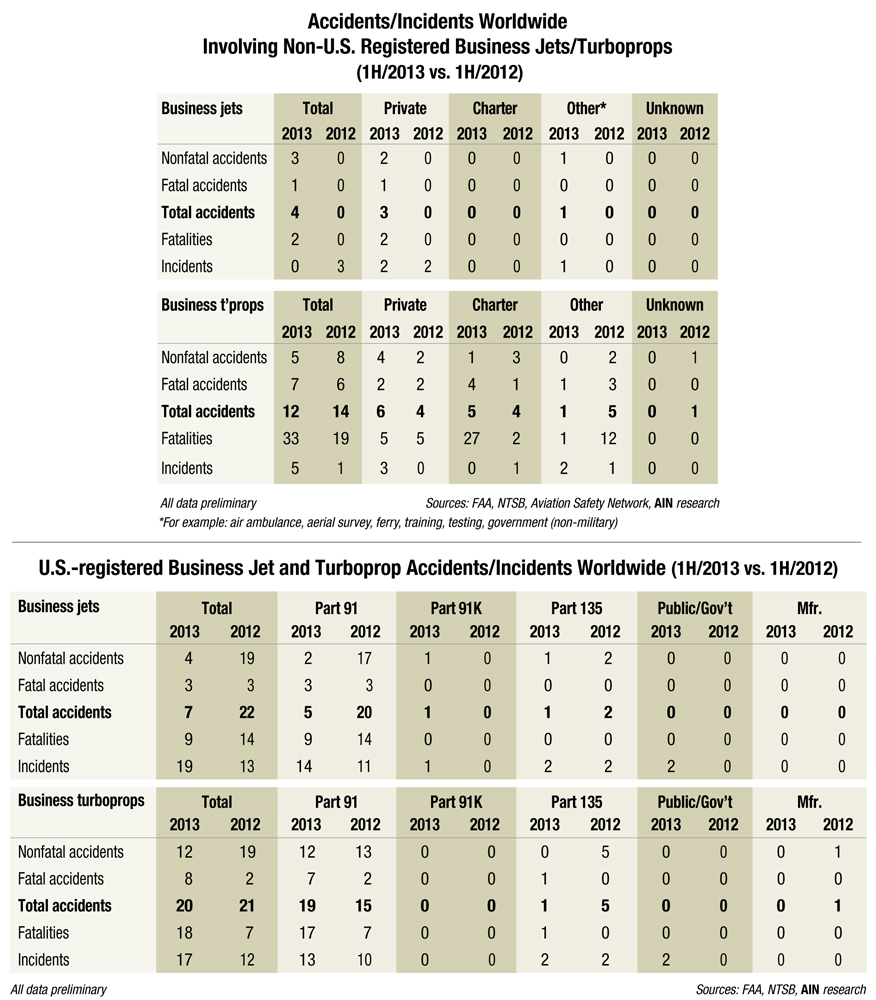
The U.S. business jet fleet worldwide recorded significantly fewer nonfatal accidents and fatalities in the first six months of this year compared with the same period last year. According to figures compiled by AIN, N-numbered business jets incurred seven accidents in the first half of this year versus 22 during the same time last year. Although these figures include three fatal jet accidents in both periods (all under FAR Part 91), the number of deaths dropped to nine in the first six months of this year compared with 14 in the like period last year. Part 91K jets suffered one accident (nonfatal) and incident in the first half of this year compared with zero events last year. This year, one Part 135 jet was involved in a nonfatal crash versus two nonfatal air taxi crashes last year. Not shown in the charts is the June 13 accident in which a Challenger 601 was substantially damaged on the ground after running into a hangar while mechanics were performing an engine test.
Nonfatal accidents involving N-numbered turboprops fell to 12 in the first half of this year from 19 in the first half of last year, but the number of fatal accidents quadrupled, to eight (all but one occurring under Part 91, the other under Part 135) from two, and the number of fatalities more than doubled, to 18 from seven. There were no mishaps involving Part 91K U.S. turboprops in either period.
There were four accidents involving non-U.S.-registered business jets (including one fatal accident involving a privately operated jet in which two people died) in the first six months compared with none in the same period last year. Of the three nonfatal jet accidents in the first half of this year, two occurred under private operations and one on a ferry flight. In this year’s first half, non-N-numbered business turboprops were involved in five non-lethal crashes (four during private operations and one operating a charter) versus eight last year. In the first half of this year, 33 people died in seven turboprop accidents compared with 19 people in six accidents last year. This year charter turboprops accounted for four of the fatal crashes as opposed to one last year.
AIN tables show “incidents” as well as “accidents” because the FAA and NTSB draw fine distinctions between the two events, the agencies are inconsistent and the status of the occurrence may change. For example, runway overruns, retracted landing gear and gear-collapse mishaps typically are listed as incidents by the FAA and not tabulated at all by the NTSB. However, if such an occurrence causes substantial damage or serious injury, the Safety Board records it as an accident. Other happenings, if they don’t result in serious damage or injury, are usually listed as incidents. They include engine shutdowns, flameouts, animal and lightning strikes, window separations, doors opening, blown tires, system malfunctions, loss of control, parts departing an airplane and severe turbulence.
by GORDON GILBERT
Back to other news
by GORDON GILBERT













